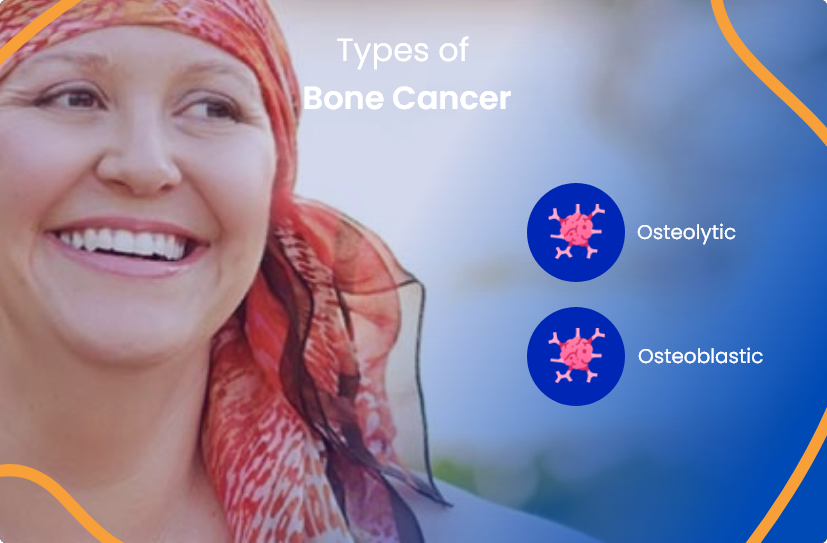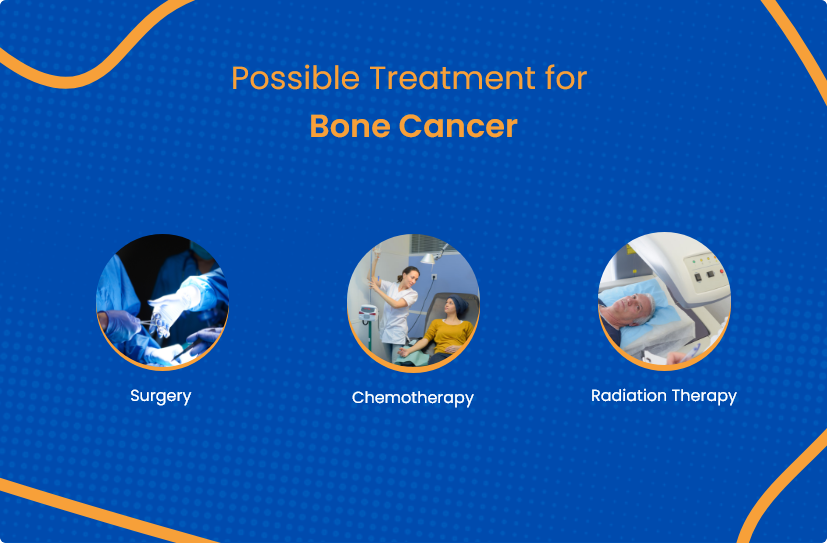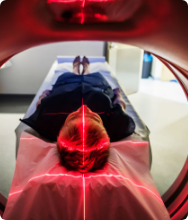
Book a Consultation
Thank you!
Your form has been sent successfully.

Bone cancer is a relatively less common type of cancer. It is the general term for several distinct malignancies that occur in the bones. It arises from excessive, abnormal cell growth within the bones. These cells damage healthy bones. The abnormal cell growths could begin in the bone or migrate there from another area of the body. Although they can appear at any age, they are more frequent in younger adults and children than in elderly people.
Cancers that form in the bone itself are called primary bone cancers. Then there are tumors that begin in other organs or other parts of the body that can spread to the bones. These growths are called secondary or metastatic bone cancers. Breast, prostate, and lung tumors can most commonly metastasize (spread) to the bones.
The most serious type of bone cancer is primary bone cancer. It develops in the bones directly or in tissues surrounding the bones, for example, cartilage. The different types of primary bone cancers include:
The upper bones of the arms (humerus), legs (femur), ribs, spine, and pelvis are most frequently impacted by secondary bone cancer (femur). Secondary bone cancer is more prevalent since the bone is one of the most common organs where cancer spreads. The two main types of secondary bone cancers are:

This type involves the breakdown of bone without the production of new bone. Sometimes the bone develops holes. The term "lytic lesions" refers to this. They may weaken the bone and raise the possibility of fractures and other issues.
In this type, some parts of the body produce new bone, but the growth is aberrant. Osteoblastic lesions are the term for these regions. Although the lesions are highly dense and hard, they weaken and distort the bone.
A lump that is typically painless is one of the most visible signs of bone cancer. There are, however, a variety of additional symptoms that can be seen. The most frequent signs of bone cancer are as follows:
 Pain (usually worse at night)
Pain (usually worse at night)
 Swelling
Swelling
 Having difficulty moving around
Having difficulty moving around
 Fatigue
Fatigue
 Fever
Fever
The treatment options for patients depend on the type, the stage, their overall health, and their preferences. The most commonly recommended treatment options for bone cancer are as follows :

For this cancer, surgery is frequently the first line of treatment. During surgery, the entire malignant tumor is removed. In the majority of cases, this entails using specialized procedures to remove the whole tumor whole, along with a tiny amount of the surrounding healthy tissue. The surgeon either uses bone from another part of the patient's body, material from a bone bank, or metal and hard plastic replacement to replace the missing bone.
Chemotherapy is commonly used in combination with other treatments and is also used to treat tumors before surgery. Chemotherapy kills cancerous cells by administering anti-cancer medications intravenously.
Surgery can either be done in addition to or instead of radiation therapy. X-rays and other powerful energy beams are used in radiation therapy to kill cancerous cells. Because radiation therapy might decrease the tumor size and make it simpler to remove, it is usually performed prior to surgery. As a result, a surgical procedure is less likely to be necessary.
Imaging tests can be used to assess the size, location, and potential spread of this disease to other body regions. The particular indications and symptoms will determine the best imaging test kinds. Testing might involve:

1. Bone scans

2. Computerized tomography (CT)

3. Magnetic resonance imaging (MRI)

4. Positron emission tomography (PET)

5. X-ray
At ACTC, our patients have access to a multispecialty team of experts who collaborate and coordinate extensively to provide all aspects of cancer care under one roof. Our doctors are supported by a clinical team with over two decades of experience and provide personalized and supportive cancer care.
The following are our providers who you can consult at ACTC:

Hematology/Oncology

Hematology/Oncology

Radiation Oncology

We realize how a cancer diagnosis and treatment affects a person's physical and mental well-being as one of Florida's leading advanced cancer centers. We, therefore, make a strong effort to ensure that patients and their families feel safe. At ACTC, we offer complete care for all types of cancer, including screening, diagnosis, staging, treatment, and long-term follow-up, all at one convenient location. Our integrated, comprehensive cancer care is delivered by a team of specialists and other cancer experts and includes everything from cutting-edge cancer treatments to supportive therapies that manage side effects if any.
Schedule a consultation by calling
 352-345-4565
352-345-4565
Bone pain, swelling, tenderness in the affected area, and fatigue can be a few of many symptoms.
The treatment depends on the type of bone cancer, the severity of the case, and the patient's age.
The human body has over 200 bones, and they can all be prone to cancer. However, the areas most susceptible to bone cancer are the pelvis, long bones in the arms and legs, and bone marrow.
Schedule a consultation by calling
 352-345-4565
352-345-4565